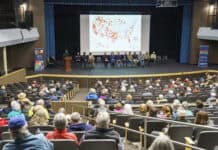Last week the Sedona City Council took the first steps toward repairing its relationship with Sedona’s business community and our workers by agreeing to fund the Uptown Visitor Center at 80% of its costs and expenses.
Admittedly, the request was a longshot after the Sedona Chamber of Commerce’s Board of Directors decided in April that they would not seek a service contract renewal to use bed tax dollars in fiscal year 2023-24.
The acrimonious divorce seemed to gut the longstanding partnership between the city of Sedona and the nonprofit business cooperative.
Although a few council members gave the impression that they were going to treat the chamber like an ex-girlfriend who wanted her records back, Councilwoman Jessica Williamson gave an impassioned argument that the role of government should be to best serve its community and better aid its businesses by using the largesse of public funds to offer financial support.
This appeared to those of us watching the debate to swing the argument on the dais.
Even those council members most likely to hold onto U2’s “The Joshua Tree” out of spite were swayed to remember the good times and give one last listen to “With or Without You.” Afterward, council did the right thing and voted — at least initially unanimously — to fund the Uptown Visitor Center.
As chamber President and CEO Michelle Conway stated, the Uptown Visitor Center is an institution, but it is also a landmark.
The Uptown stretch is Sedona’s economic center for most visitors, or at least certainly what they think of first when asked about Sedona’s commercial sector. The visitor center is perched on a hill overlooking the gateway to Uptown at Forest Road, and for every visitor turning left at that road to find a parking spot, the visitor center is a pivot point. It has outdoor-accessible public restrooms. It has public art. For visitors who use rack cards and seek advice when visiting a new town, it’s the first place they stop. It’s also a convenient gathering point for visitors who get separated or who carpool to meet up even if they never set foot inside the building.
For those of us who enjoy walking Uptown at Halloween with our children, it’s the terminus for the loop around Uptown.
Shuttering the building — which the Chamber of Commerce would likely have to do without the support of the city — would signal an economic downturn and become a blight marring the entrance to our city.
Council did the right thing in supporting the request, even if the unanimous vote initially turned into a 4-3 vote when council split hairs over the dollar amount. Considering that the council gave $2 million at the same meeting to six other nonprofits, that the council’s budget next year is around $84.5 million and that an extra $55,200 is less than pocket change — technically $0.00065 of every dollar — the hardline was odd.
In all honesty, many of Sedona’s biggest problems — traffic, overcrowding on trails and a housing shortage stemming from property owners converting their homes into short-term rentals to profit from visitors — are a direct result of increased tourism numbers.
While we can’t do much to control the invisible hand of the market and the decisions of private homeowners, the failure to relieve the congestion lies in the fact the city of Sedona and governments in the region at large have not adapted our infrastructure to handle the increased numbers.
We have a State Route 179 essentially unchanged from what it was in 1978, albeit with prettier sidewalks and more roundabouts. There is no way to get from West Sedona to the east except for one five-lane road that can be shut down by accidents, asphalt repair or holiday congestion. Our residential subdivisions are largely islands not connected to adjacent neighborhoods, so drivers from every subdivision must travel a state highway whether leaving town or going to visit a friend one street over.
No amount of micromanaging a chamber of commerce to “manage” tourism is going to alleviate these problems. Yet successive councils, not just this one, have greatly overstepped their bounds in an attempt to micromanage the chamber for political gain.
Councils have declined to make hard choices like condemning private parcels to build connecting roads, or begging the Arizona Department of Transportation to widen State Route 179, or getting legislation passed in the Arizona State Legislature.
This vote to fund the Visitor Center demonstrates that this council is perhaps willing to move beyond the years of political micromanaging by previous councils and support the business community with its landmark building and the goodwill it generates with visitors who want to take hikes and photos and leave their dollars and sales taxes behind to benefit everyone who live here.
